Submitted:
19 April 2023
Posted:
19 April 2023
You are already at the latest version
Abstract
Keywords:
1. Introduction
2. Geological settings
2.1. Lower Cambrian bitumen in Guangyuan area, western Sichuan Basin
2.2. Middle–Lower Ordovician heavy oil in Aiding area in Tahe oilfield, Tarim Basin
3. Experimental
3.1. Samples
3.1.1. Lower Cambrian bitumen in Guangyuan area, Sichuan Basin
3.1.2. Middle–Lower Ordovician oil in Aiding area in Tahe oilfield, Tarim Basin
3.2. Pretreatment of bitumen and oil samples
3.3. Instrumental analysis
4. Results and discussion
4.1. Petroleum generation time and origin of the Lower Cambrian bitumen in the Guangyuan area, western Sichuan Basin
4.1.1. Petroleum generation time of the solid bitumen
4.1.2. Source rock correlation to the solid bitumen
4.2. Generation time of heavy oil in the Middle–Lower Ordovician in the Aiding area, Tahe Oilfield
5. Conclusions
Author Contributions
Funding
Data Availability Statement
Conflicts of Interest
References
- Kang, Y.Z. Geological characteristics of the formation of the large Tahe oilfield in the Tarim basin and its prospects. Geol. China, 2003, 30, 315–319. [Google Scholar] [CrossRef]
- Liu, S.G.; Ma, Y.S.; Sun, W.; Cai, X.Y.; Liu, S.; Huang, W.M.; Xu, G.S.; Yong, Z.Q.; Wang, G.Z.; Wang, H. Studying on the differences of Sinian natural gas pools between Weiyuan gas field and Ziyang gas–brone area, Sichuan Basin. Acta Geol. Sin. 2008, 82, 328–337. [Google Scholar] [CrossRef]
- Jiao, F.Z. Significance and prospect of ultra–deep carbonate fault–karst reservoirs in Shunbei area, Tarim Basin. Oil Gas Geol. 2018, 39, 207–216. [Google Scholar] [CrossRef]
- Wang, T.G.; Han, K.Y. On Meso–Neoproterozoic primary petroleum resources. Acta Pet. Sin. 2011, 32, 1–7. [Google Scholar] [CrossRef]
- Qi, L.X. Exploration practice and prospects of giant carbonate field in the Lower Paleozoic of Tarim Basin. Oil Gas Geol. 2014, 35, 771–779. [Google Scholar] [CrossRef]
- Ma, Y.S.; Cai, X.Y.; Yun, L.; Li, Z.J.; Li, H.L.; Deng, S.; Zhao, P.R. Practice and theoretical and technical progress in exploration and development of Shunbei ultra-deep carbonate oil and gas field, Tarim Basin, NW China. Pet. Explor. Dev. 2022, 49, 1–17. [Google Scholar] [CrossRef]
- Li, J.; Yang, C.L.; Xie, W.R.; Rui, Y.R.; Wang, X.B.; Zhang, L.; Xie, Z.Y.; Guo, Z.Q. Differences of natural gas accumulation and play fairways in the marginal zone and interior of Sinian platform in Anyue gas field, Sichuan Basin. Oil Gas Geol. 2023, 44, 34–45. [Google Scholar] [CrossRef]
- Zhang, L.; Wei, G.Q.; Li, X.Z.; Wang, Z.C; Xiao, X.M. The thermal history of Sinian-Lower Paleozoic high-over mature source rock in Sichuan basin. Nat. Gas Geosci. 2007, 18, 4–9. [Google Scholar] [CrossRef]
- Wu, Y.Q.; Wang, Y.L.; Lei, T.Z. Ma S. P.; Wang Y.X.; Wen Q.B.; Xia Y.Q. Study on pristane isomerization index, a possible thermal maturity index for highly and overly mature source rocks of the Lower Paleozoic. J. Chin. Mass Spectrom. Soc. 2014, 35, 317–323. [Google Scholar] [CrossRef]
- Ma, X.H.; Yang, Y.; Wen, L.; Luo, B. Distribution and exploration direction of medium-large sized marine carbonate gas fields in Sichuan Basin, SW China. Pet. Explor. Dev. 2019, 46, 1–13. [Google Scholar] [CrossRef]
- Huang, D.F.; Wang, L.S. Geochemical characteristics of bituminous dike in Kuangshanliang area of the Northwestern Sichuan Basin and its significance. Acta Petrol. Sin. 2008, 29, 23–28. [Google Scholar] [CrossRef]
- Xiang, C.F.; Tang, L.J.; Li, R.F.; Pang, X.Q. Episodic fluid movements in superimposed basin: Combined evidence from outcrop and fluid inclusions of the Majiang ancient oil reservoir, Guizhou Province. Sci. China, Ser. D: Earth Sci. 2008, 51, 78–87. [Google Scholar] [CrossRef]
- Li, M.W.; Snowdon, L.; Lin, R.Z.; Wang, P.R.; Hou, D.J.; Zhang, L.Y.; Zhang, S.C.; Liang, D.G.; Xiao, Z.Y. Migrated hydrocarbons in outcrop samples: revised petroleum exploration directions in the Tarim basin. Org.Geochem. 2000, 31, 599–603. [Google Scholar] [CrossRef]
- Liu, G.X.; Wang, S.D.; Pan, W.L.; Lv, J.X. Characteristics of Tiannjingshan destroyed oil reservoir in Guangyuan Area, Sichuan. Mar. Orig. Pet. Geol. 2003, 8, 103–107. [Google Scholar] [CrossRef]
- Ma, A.L.; Zhang, S.C.; Zhang, D.J. ajiang, et al. Oil and source correlation in Lunnan and Tahe heavy oil fields. Oil Gas Geol. 2004, 25, 31–38. [Google Scholar] [CrossRef]
- Xie, B.H.; Wang, L.S.; Zhang, J.; Chen, S.J. Vertical distribution and geochemical behaviours of the hydrocarbon source rocks in the North section of Longmen Mountains. Nat. Gas Ind. 2003, 25, 21–23. [Google Scholar] [CrossRef]
- Zhao, J.Z. Geochronology of petroleum accumulation: new advances and the future trend. Adv. Earth Sci. 2002, 17, 378–383. [Google Scholar] [CrossRef]
- Saigal, G. , Bjorlykke K., Later S. The effects of oil emplacement on diagenetic process: Examples from the Fulmar reservoir sandstones, Central North Sea. AAPG Bull. 1992, 76, 1024–1033. [Google Scholar] [CrossRef]
- Thiery, R. , Pironon J., Walgenwitz F., Montel F. Individual characterization of petroleum fluid inclusions (composition and p-t trapping conditions) by microthermometry and confocal laser scanning microscopy: inferences from applied thermodynamics of oils. Mar. Pet. Geol. 2002, 19, 1365–1375. [Google Scholar] [CrossRef]
- Liu, W.H.; Wang, J.; Tao, C.; Hu, G.; Lu, L.F.; Wang, P. The geochronology of petroleum accumulation of China marine sequence. Nat. Gas Geosci. 2013, 24, 199–209. [Google Scholar] [CrossRef]
- Shepherd, T.J. Fluid inclusion Rb–Sr isochrons for dating mineral deposits. Nature, 1981, 290, 578–579. [Google Scholar] [CrossRef]
- Luck, J.M.; Allegre, C.J. The study of molybdenites through the 187Re–187Os chronometer. Earth Planet. Sci. Lett. 1982, 61, 291–296. [Google Scholar] [CrossRef]
- Parnell, J.; Swainbank, I. Pb–Pb dating of hydrocarbon migration into a bitumen–bearing ore deposit, North Wales. Geology, 1990, 18, 1028–1030. [Google Scholar] [CrossRef]
- Lee, M.C.; Aronson, J.L.; Savin, S.M. K/Ar dating of time of gas emplacement in Rotliegendes Sandstone, Netherlands. AAPG Bull. 1985, 69, 1381–1385. [Google Scholar] [CrossRef]
- Hamilton, P.J.; Kelly, S.; Fallick, A.E. K–Ar dating of illite in hydrocarbon reservoirs. Clay Miner. 1989, 24, 215–231. [Google Scholar] [CrossRef]
- Liewig, N.; Clauer, N.; Sommer, F. Rb–Sr and K–Ar dating of clay diagenesis in Jurassic sandstone oil reservoir, North Sea. AAPG Bull. 1987, 71, 1467–1474. [Google Scholar] [CrossRef]
- Mossman, D.J.; Nagy, B.; Davis, D.W. Hydrothermal alteration of organic matter in uranium ores, Elliot Lade, Canada: implication for selected organic–rich deposits. Geochim. Cosmochim. Acta, 1993, 57, 3251–3259. [Google Scholar] [CrossRef]
- Zhang, Y.Y.; Zwingmann, H.; Todd, A.; Liu, K.Y.; Luo, X.Q. K–Ar dating of authigenic illite and its applications to study of oil–gas charging histories of typical sandstone reservoirs, Tarim Basin, Northwest China. Earth Sci. Front. 2004, 11, 637–648. [Google Scholar] [CrossRef]
- Wang, L.Z.; Dai, T.M.; Peng, P.A. 40Ar/39Ar dating of diagenetic illites and its application in timing gas emplacement in gas reservoirs. Earth Science, 2005, 30, 78–82. [Google Scholar] [CrossRef]
- Chen, J.X.; Wang, B.; Guo, X.W.; Cao, Z.C.; Liu, Y.L.; Geng, F.; Zhang, X.Y.; Xu, H.; Zhao, J.X. Application of laser in-situ U-Pb dating of calcite to determination of the absolute time of hydrocarbon accumulation in polycyclic superimposed basins: a case study on Tahe oilfield Tarim basin. Oil Gas Geol. 2021, 42, 1365–1375. [Google Scholar] [CrossRef]
- Cong, F.Y.; Tian, J.Q.; Hao, F.; Andrew, R.C.; Kylander, C.; Pan, W.Q.; Zhang, B.S. Calcite U-Pb ages constrain petroleum migration pathways in tectonic complex basins. Geology, 2022, 50, 644–649. [Google Scholar] [CrossRef]
- Wang, F.Y.; He, P.; Zhang, S.C. Zhao M.J.; Lei J.J. The K–Ar isotope dating of authigenic illites and timing of hydrocarbon fluid emplacement in sandstone reservoirs. Geol. Rev. 1997, 43, 540–546. [Google Scholar] [CrossRef]
- Jiang, Z.X.; Pang, X.Q.; Huang, Z.L. A method for studying the oil and gas migration stages in superposed basin and its application. Petrol. Explor. Dev. 2000, 27, 22–25. [Google Scholar] [CrossRef]
- Wang, L.Z.; Han, K.Y.; Xie, B.H.; Zhang, J.; Du, M.; Wan, M.X.; Li, D. Reservoiring conditions of the oil and gas fields in the north section of Longmen Mountain nappe structural belts. Nat. Gas Ind. 2005, 27 (Supple. A), 1–5, DOI: CNKI: SUN: TRQG.0.2005-S1-000. [Google Scholar]
- Qiu, H.N.; Wu, H.Y.; Feng, Z.H.; Shi, H.S.; Yun, J.B.; Wang, Q.; Zhao, L.H. The puzzledom and feasibility in determining emplacement ages of oil/gas reservoirs by 40Ar/39Ar techniques. Geochimica, 2009, 38, 405–411. [Google Scholar] [CrossRef]
- Shi, H.S.; Zhu, J.Z.; Qiu, H.N.; Shu, Y.; Wu, J.Y.; Long, Z.L. Timing of hydrocarbon fluid emplacement in sandstone reservoirs in Neogene in Huizhou Sag, Southern China Sea, by authigenic illite 40Ar/39Ar laser stepwise heating. Earth Sci. Front. 2009, 16, 290–295. [Google Scholar] [CrossRef]
- Tu, X.L.; Zhu, B.Q.; Zhang, J.L.; Liu, Y.; Liu, J.Y.; Shi, Z.E. Pb–Sr–Nd isotope application in geochronology and origin of petroleum. Geochimica, 1997, 26, 57–67. [Google Scholar] [CrossRef]
- Zhang, J.L; Zhang, N.; Zhu, B.Q.; Tu, X.L.; Liu, J.Y.; Liu, Y.; Shi, E.Z.; Zhang, P.Z. Pb–Sr–Nd isotope geochemistry of the bitumen veins in Urho, Karamay. Sci. China, Ser. D: Earth Sci. 1997, 27, 325–330. [Google Scholar] [CrossRef]
- Zhu, B.Q.; Zhang, J.L.; Tu, X.L.; Chang, X.Y.; Fan, C.Y.; Liu, Y.; Liu, J.Y. Pb, Sr and Nd isotopic features in organic matter from China and their implications for petroleum generation and migration. Geochim. Cosmochim. Acta, 2001, 65, 2555–2570. [Google Scholar] [CrossRef]
- Wang, H.J.; Zhang, S.C.; Wang, X.M. How to achieve the precise dating of hydrocarbon accumulation. Nat. Gas Geosci. 2013, 24, 210–217. [Google Scholar] [CrossRef]
- Selby, D.; Creaser, R.A. Direct radiometric dating of hydrocarbon deposits using rhenium–osmium isotopes. Science, 2005, 308, 1293–1295. [Google Scholar] [CrossRef] [PubMed]
- Selby, D.; Creaser, R.A.; Fowler, M.G. Re–Os elemental and isotopic systematics in crude oils. Geochim. Cosmochim. Acta, 2007, 71, 378–386. [Google Scholar] [CrossRef]
- Rooney, A.D.; Selby, D.; Lewan, M.D.; Lillis, P.G.; Houzay, J.P. Evaluating Re–Os systematics in organic–rich sedimentary rocks in response to petroleum generation using hydrous pyrolysis experiments. Geochim. Cosmochim. Acta, 2012, 77, 275–291. [Google Scholar] [CrossRef]
- Yamashita, Y.; Takahashi, Y.; Haba, H.; Enomoto, S.; Shimizu, H. Composition of reductive accumulation of Re and Os in seawater–sediment system. Geochim. Cosmochim. Acta, 2007, 71, 3458–3475. [Google Scholar] [CrossRef]
- Jacob, H. Classification, structure, genesis and practical importance of natural solid oil bitumen (“migrabitumen”). Int. J. Coal Geol. 1989, 11, 65–79. [Google Scholar] [CrossRef]
- Ding, Y.; Peng, S.T.; Xia, D.L. The reservoir characteristics and hydrocarbon accumulation stages of Ordovician in Aiding area of Tahe Oilfield, Tarim Basin. Xinjiang Petrol. Geol. 2013, 34, 262–264, DOI: CNKI:SUN:XJSD.0.2013-03-007. [Google Scholar]
- Geboy, N.J.; Kaufman A., J.; Walker, R.J.; Misi, A.; Oliviera, T.F.; Miller K., E.; Azmy, K.; Kendall, B.; Poulton, S.W. Re-Os age constraints and new observations of Proterozoic glacial deposits in the Vazante Group, Brazil. Precambrian Res. 2013, 238, 199–213. [Google Scholar] [CrossRef]
- Liang, X.; Liu S., G.; Mo, Q.W.; Sun, W.; Deng, B.; Xia, G.D.; Xiong, L.P.; Li, Z.Q. The characteristics of marine hydrocarbon accumulation and its exploration prospects in the northern section of Western Sichuan Depression, China. J. Chengdu Univ. Technol. 2018, 45, 53–67. [Google Scholar]
- Creaser, R.A.; Sannigrahi, P.; Chacko, T.; Selby, D. Further evaluation of the Re–Os geochronometer in organic rich sedimentary rocks: A test of hydrocarbon maturation effects in the Exshaw Formation, Western Canada Sedimentary Basin. Geochim. Cosmochim. Acta, 2002, 66, 3441–3452. [Google Scholar] [CrossRef]
- Finlay, A.J.; Selby, D.; Osborne, M.J. Re–Os geochronology and fingerprinting of United Kingdom Atlantic margin oil: Temporal implications for regional petroleum systems. Geology, 2011, 39, 475–478. [Google Scholar] [CrossRef]
- Liu, W.H.; Wang, J.; Tenger; Zhang D. W.; Rao D.; Tao C. New knowledge of gas source rocks in the marine sequences of South China and relevant index system for tracing. Oil Gas Geol. 2010, 31, 819–824, DOI: CNKI: SUN: SYYT.0.2010-06-01. [Google Scholar]
- Wang, J.; Liu, W.H.; Tenger; Qin J. Z.; Zheng L.J. Thermal pyrolysis of hydrocarbon generation for marine hydrocarbon sources in marine sequence of South China and stable carbon isotopes of gas products. Nat. Gas Geosci. 2011, 22, 684–691. [Google Scholar] [CrossRef]
- Tian, X.B. Structural characteristics and petroleum prospect in the North section of Longmen Mountain. Beijing: National Library of China, 2009.
- Han, K.Y. Origin of the overthrust zone in Longmen Mountains and its oil and gas prospect. Nat. Gas Ind. 1984, 4, 1–9, DOI: CNKI: SUN: TRQG.0.1984-04-001. [Google Scholar]
- Wang, G.L.; Wang, T.G.; Han, K.Y.; Wang, L.S.; Shi, S.B. Organic geochemical characteristics and origin of solid bitumen and oil sands in northwestern Sichuan. Pet. Geol. Exp. 2014, 36, 731–735. [Google Scholar] [CrossRef]
- Dai, H.S.; Liu, S.G.; Sun, W.; Han, K.Y.; Luo, Z.L.; Xie, Z.L.; Huang, Y.Z. Study on characteristics of Sinian–Silurian bitumen outcrops in the Longmen–Micang shan area, Southwest China. J. Chengdu Univ. Technol. 2009, 36, 687–696. [Google Scholar] [CrossRef]
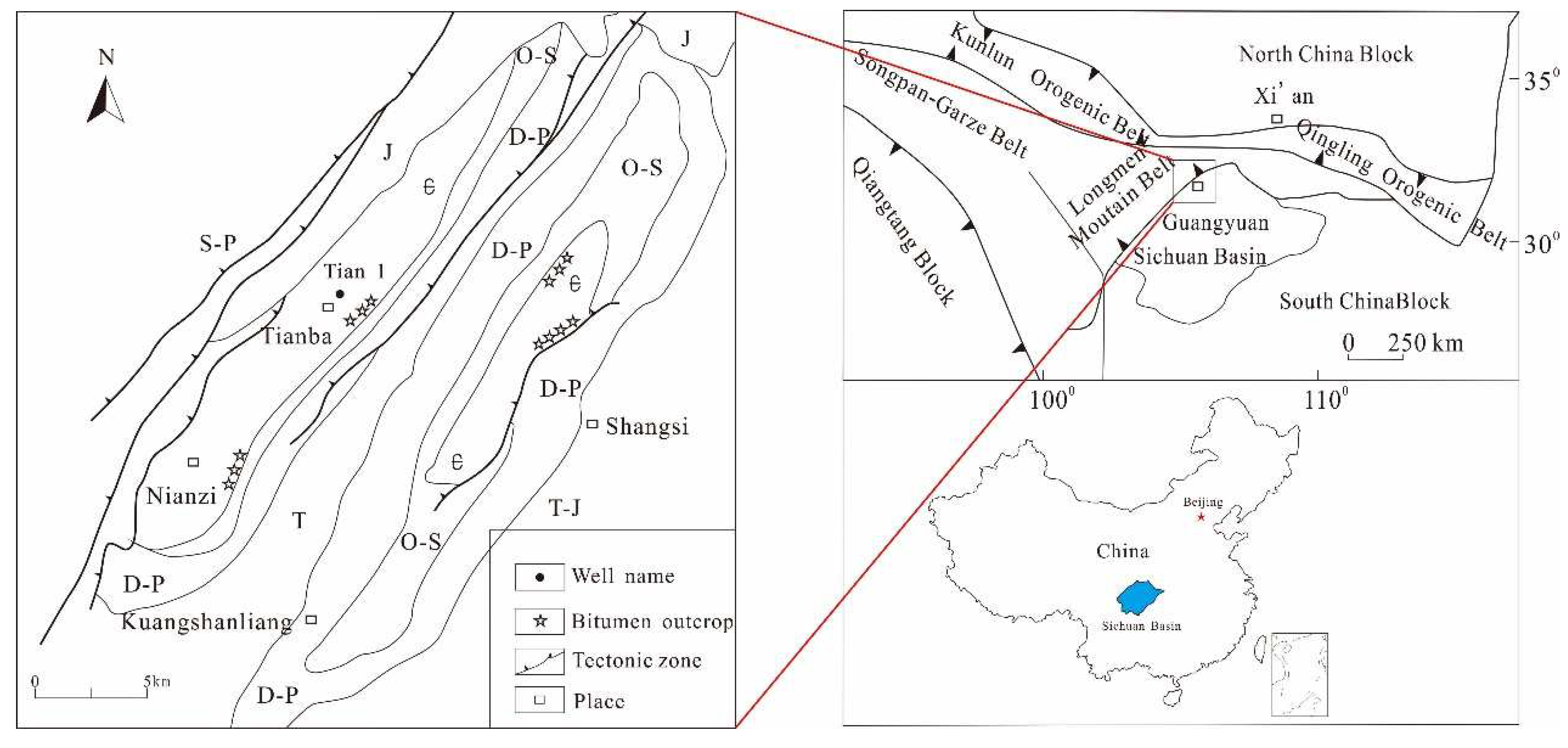

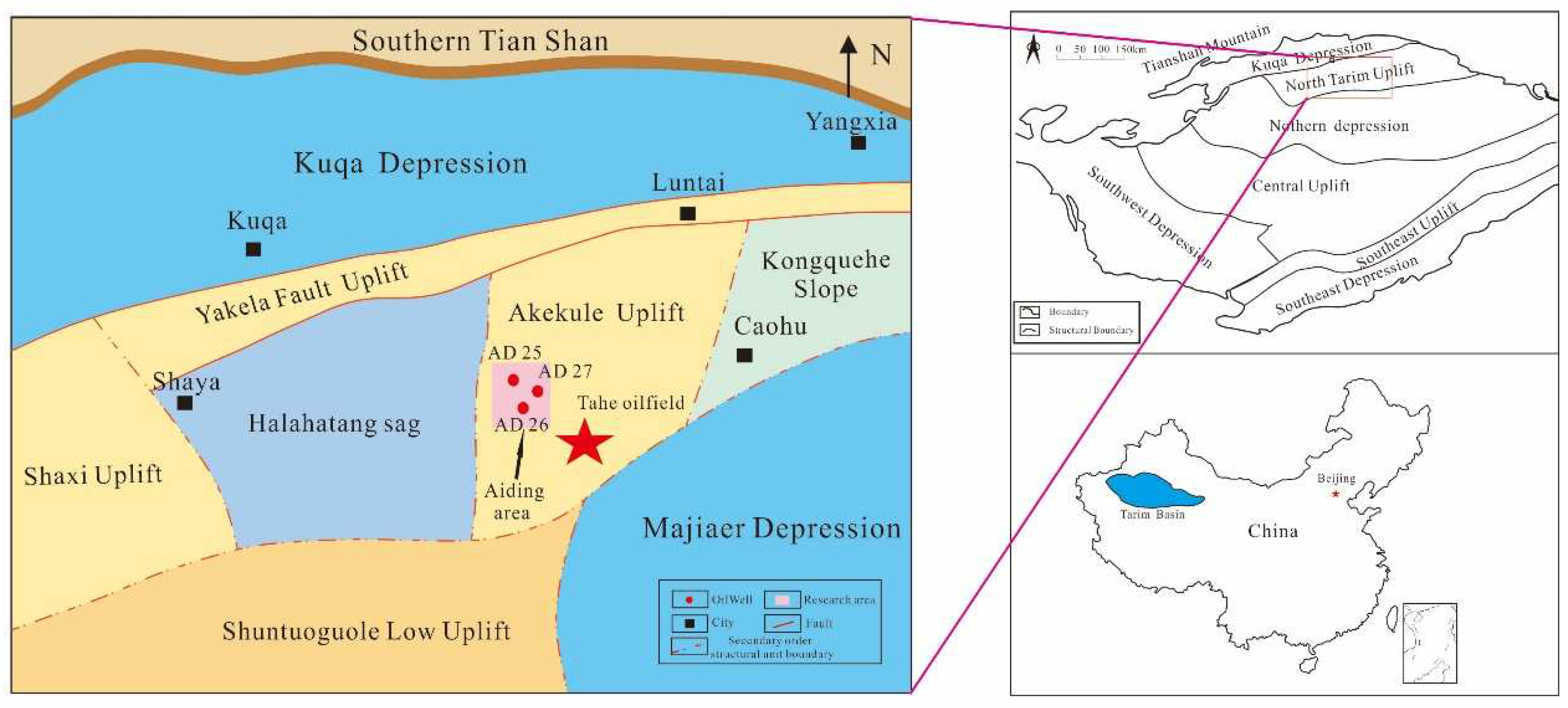
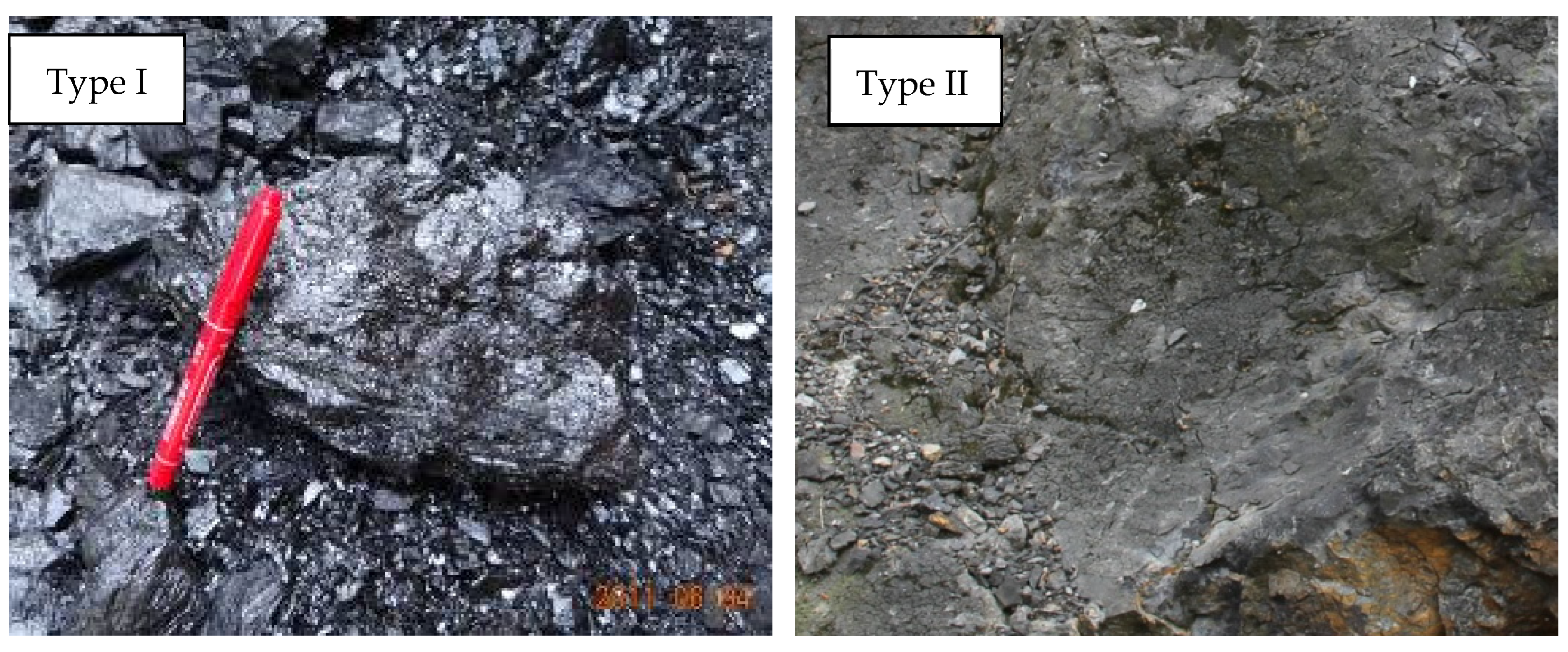
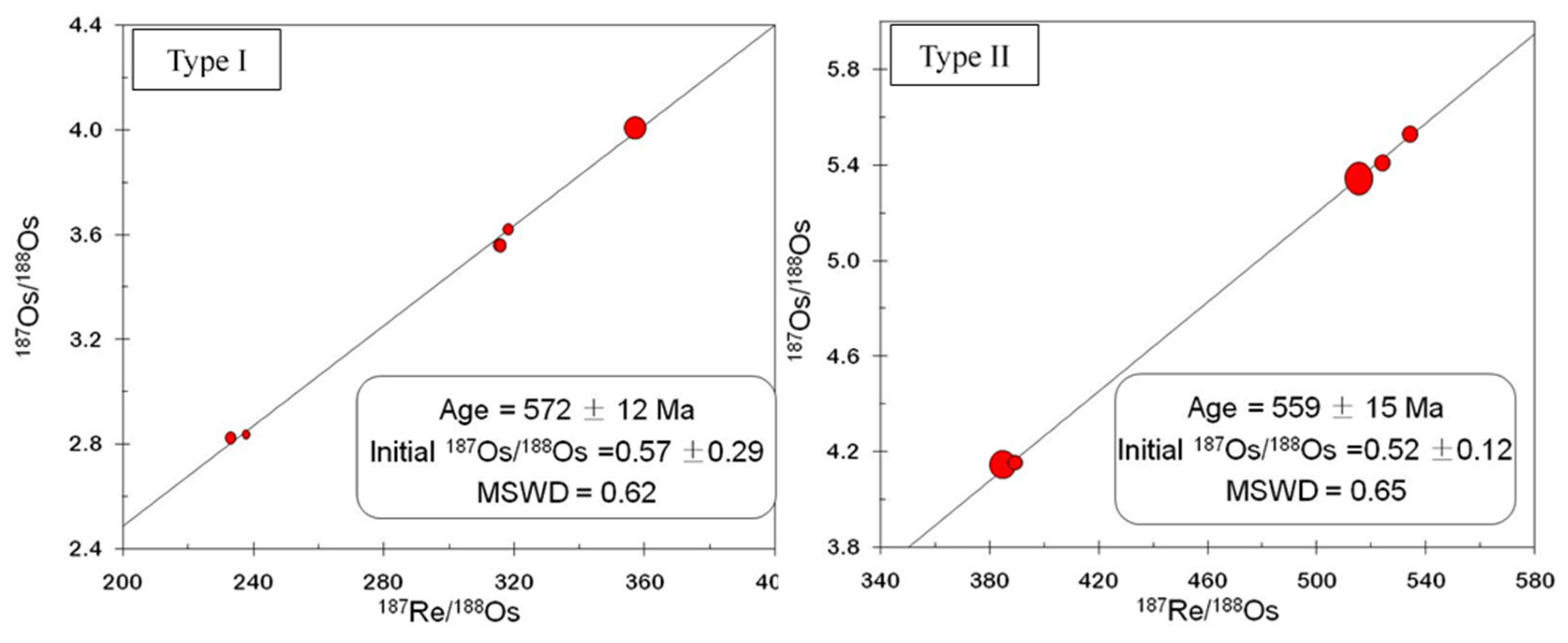
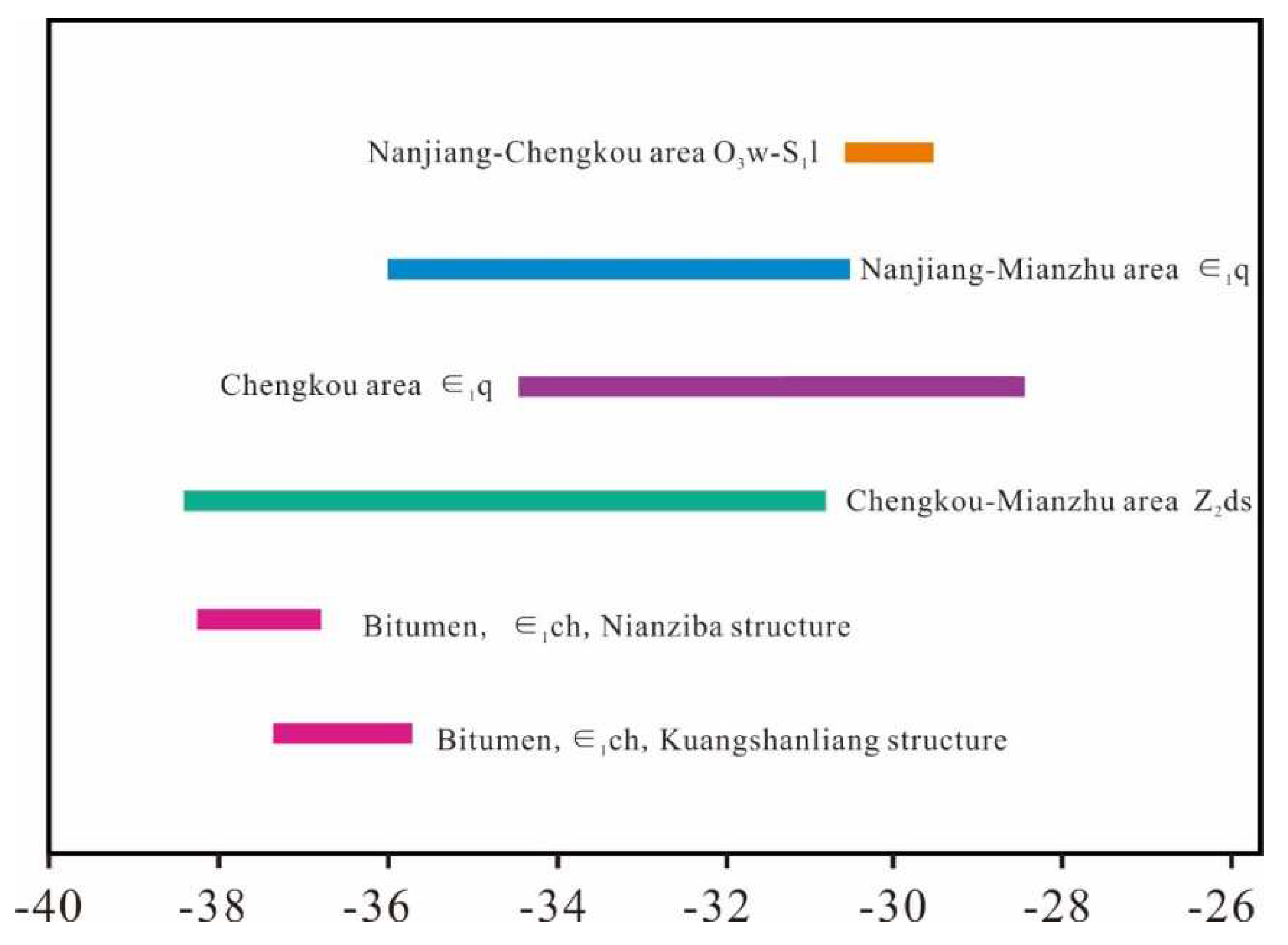
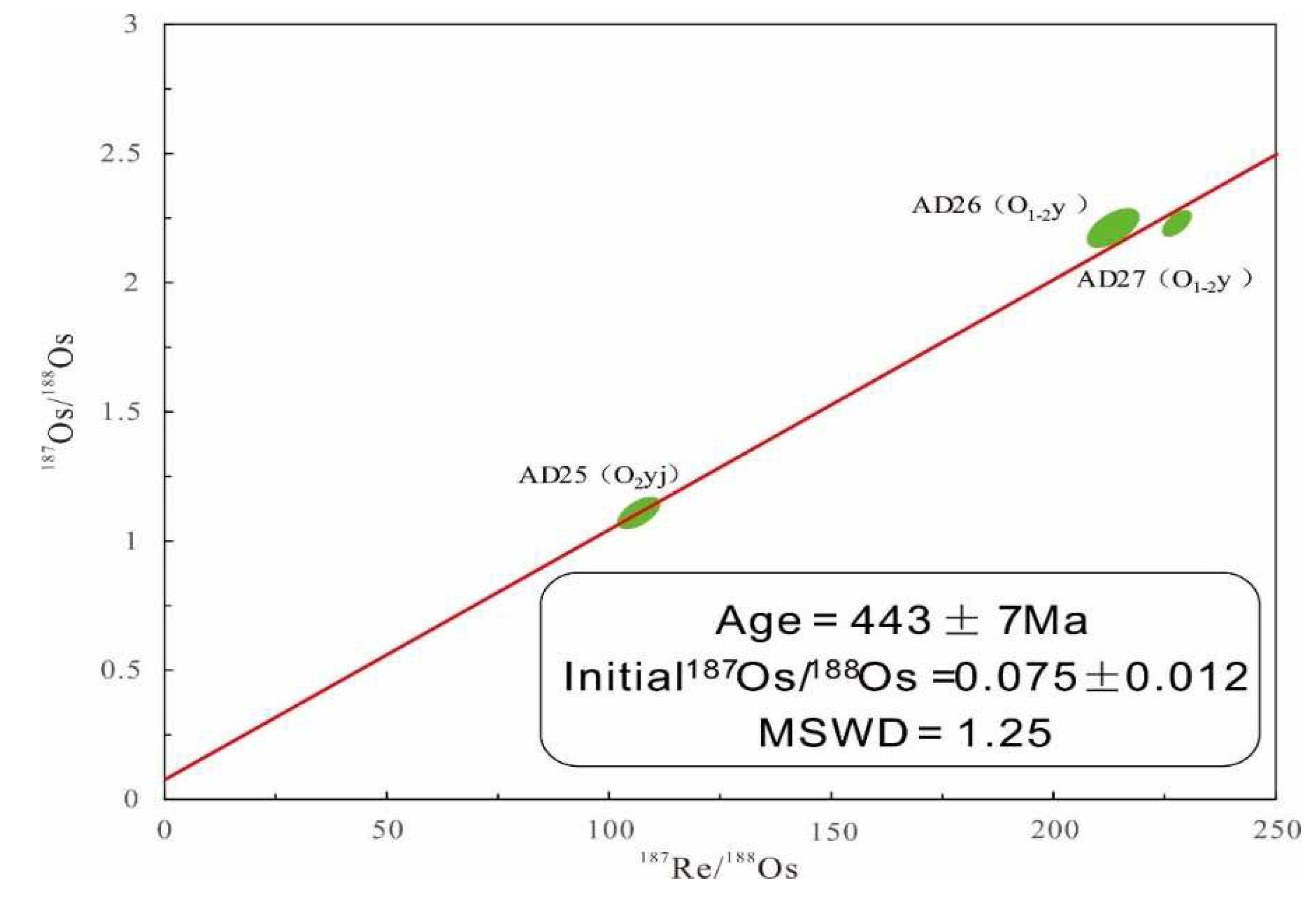
| No. | Sample No. | Sample type | Section | Formation | Rb(%) | Ro(%) |
|---|---|---|---|---|---|---|
| 1 | GY–1 | Type I bitumen | Bitumen pit in Kuangshanliang structure | ∈1ch | 0.50 | 0.71 |
| 2 | GY–3 | Type I bitumen | Bitumen pit in Kuangshanliang structure | ∈1ch | 0.48 | 0.70 |
| 3 | GY–5 | Type I bitumen | Bitumen pit in Kuangshanliang structure | ∈1ch | 0.38 | 0.63 |
| 4 | GY–6 | Type I bitumen | Bitumen pit in Kuangshanliang structure | ∈1ch | 0.45 | 0.68 |
| 5 | JF–1 | Type II bitumen | Bitumen pit in Nianziba structure | ∈1ch | 0.40 | 0.65 |
| 6 | JF–4 | Type II bitumen | Bitumen pit in Nianziba structure | ∈1ch | 0.41 | 0.65 |
| Sample No. | Structure | ω (Re) / (ng.g−1) |
ω (Os) / (ng.g−1) |
ω (187Os) / (ng.g−1) |
187Re/188Os | 187Os/188Os | |||||
|---|---|---|---|---|---|---|---|---|---|---|---|
| Data | 2σ | Data | 2σ | Data | 2σ | Data | 2σ | Data | 2σ | ||
| GY–1 | Kuangshanliang | 298.9 | 0.9 | 4.571 | 0.015 | 2.124 | 0.009 | 314.9 | 1.4 | 3.559 | 0.019 |
| GY–2 | Kuangshanliang | 345.9 | 1 | 5.24 | 0.016 | 2.475 | 0.01 | 317.8 | 1.3 | 3.619 | 0.018 |
| GY–3 | Kuangshanliang | 510 | 1.8 | 10.556 | 0.048 | 3.893 | 0.019 | 232.6 | 1.3 | 2.825 | 0.019 |
| GY–4 | Kuangshanliang | 534.5 | 1.6 | 10.841 | 0.035 | 4.014 | 0.016 | 237.4 | 1 | 2.836 | 0.014 |
| GY–5 | Kuangshanliang | 358.7 | 1.1 | 5.476 | 0.019 | 2.542 | 0.011 | 315.3 | 1.4 | 3.556 | 0.02 |
| GY–6 | Kuangshanliang | 277.8 | 0.8 | 3.765 | 0.044 | 1.988 | 0.019 | 355.2 | 4.2 | 3.985 | 0.02 |
| JF–1 | Nianziba | 592.9 | 1.8 | 5.349 | 0.017 | 3.858 | 0.015 | 533.6 | 2.3 | 5.525 | 0.028 |
| JF–2 | Nianziba | 545.1 | 1.6 | 5.014 | 0.016 | 3.539 | 0.014 | 523.4 | 2.3 | 5.407 | 0.027 |
| JF–3 | Nianziba | 477.7 | 1.4 | 4.467 | 0.033 | 3.114 | 0.023 | 514.9 | 4.1 | 5.34 | 0.056 |
| JF–4 | Nianziba | 497.6 | 2.9 | 6.232 | 0.053 | 3.374 | 0.027 | 384.4 | 3.9 | 4.147 | 0.048 |
| JF–5 | Nianziba | 539.62 | 2.36 | 6.68 | 0.024 | 3.622 | 0.015 | 388.9 | 2.2 | 4.154 | 0.023 |
Disclaimer/Publisher’s Note: The statements, opinions and data contained in all publications are solely those of the individual author(s) and contributor(s) and not of MDPI and/or the editor(s). MDPI and/or the editor(s) disclaim responsibility for any injury to people or property resulting from any ideas, methods, instructions or products referred to in the content. |
© 2023 by the authors. Licensee MDPI, Basel, Switzerland. This article is an open access article distributed under the terms and conditions of the Creative Commons Attribution (CC BY) license (http://creativecommons.org/licenses/by/4.0/).




